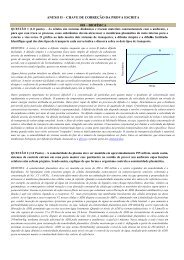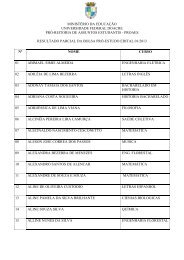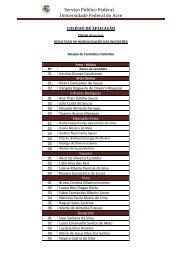Revista Brasileira de Ornitologia - Universidade Federal do Acre
Revista Brasileira de Ornitologia - Universidade Federal do Acre
Revista Brasileira de Ornitologia - Universidade Federal do Acre
You also want an ePaper? Increase the reach of your titles
YUMPU automatically turns print PDFs into web optimized ePapers that Google loves.
Birds of the Brazilian state of <strong>Acre</strong>: diversity, zoogeography, and conservationEdson Guilherme409The hybridization zone of eastern <strong>Acre</strong> is supportedby the observation of transitional forms of the taxaBrotogeris cyanoptera cyanoptera/beniensis and Momotusmomota simplex/cf. nattereri. The existence of the westernzone was supported only by the taxa Pteroglossus castanotiscastanotis/australis. In this case, the specimen MPEG26747 from the upper Juruá, which was originallyclassified as P. c. australis by Novaes (1957), presentsplumage traits and external morphology, such as the billcolor and shape, that appear to be intermediate betweenP. c. castanotis and P. c. australis. In addition to these twotaxa, it seems likely that other transitional forms may existbetween Dendrocolaptes certhia juruanus and polyzonus,given that they both occur within the same region. As thepresent study did not inclu<strong>de</strong> the most mo<strong>de</strong>rn analyticaltechniques available (e.g., molecular genetics andvocalization analyses), the two principal hybridizationzones i<strong>de</strong>ntified here were consi<strong>de</strong>red to be “probable”rather than <strong>de</strong>finitive. Obviously, the confirmation ofthe status of these zones will <strong>de</strong>pend on the collection ofmore <strong>de</strong>tailed data, <strong>de</strong>rived from more extensive surveysusing alternative scientific approaches.Haffer (1987, p. 140) presented a map showinga wi<strong>de</strong> hybridization zone that begins in the foothillsof the An<strong>de</strong>s, in northeastern Peru, and extends as faras the Amazonian lowlands, crossing the upper Juruáin <strong>Acre</strong>, which corresponds exactly to the westernhybridization zone i<strong>de</strong>ntified in the present study. Eventhough Haffer (1987) did not provi<strong>de</strong> informationon the taxa supporting his southwestern Amazonianhybridization zone, the parapatric distribution oftaxa such as P. c. castanotis and P. c. australis, andDendrocolaptes certhia juruanus and polyzonus in western<strong>Acre</strong> provi<strong>de</strong> some additional evi<strong>de</strong>nce for the existenceof this hybridization zone.Conservation<strong>Acre</strong> is covered almost entirely by Amazonianrainforest (<strong>Acre</strong> 2000), although 11% of its originalforest cover has been lost as a consequence of recenthuman activities in the region (Souza et al. 2006). Evenso, <strong>Acre</strong> is still one of the least <strong>de</strong>forested of BrazilianAmazonian states (Fearnsi<strong>de</strong> 1993). One of the principalreasons for this has almost certainly been the creation andconsolidation of a wi<strong>de</strong> network of protected areas, whichnow covers almost half of the state’s territory (<strong>Acre</strong> 2000).The i<strong>de</strong>ntification of taxa that only occur in habitatsthat are either un<strong>de</strong>r-represented or non-existent in thestate’s protected areas pointed clearly to two main gaps inits conservation coverage: the campinas and campinaranasof westermost <strong>Acre</strong> and the <strong>de</strong>nse lowland rainforests ofthe extreme eastern portion of the state.The campinas and campinaranas of western <strong>Acre</strong>must be protected not only because these habitats arenot represented a<strong>de</strong>quately in any of the state’s protectedareas, but primarily because some bird species are onlyfound in these habitats (see Guilherme & Borges 2011).The creation of protected areas within the <strong>de</strong>nse rainforestof easternmost <strong>Acre</strong> is strongly encouraged due to thepresence of taxa associated specifically with this type ofhabitat, such as Lepi<strong>do</strong>thrix coronata exquisita. Other taxawith similar distributions inclu<strong>de</strong> Brotogeris cyanopterabeniensis, Momotus momota simplex, and Hemitriccusminor. These zoogeographic consi<strong>de</strong>rations are furtheremphasized by the fact that eastern <strong>Acre</strong> <strong>de</strong>nse lowlandrainforests are within the most <strong>de</strong>nsely-populated partof the state, which has suffered high <strong>de</strong>forestation rates(<strong>Acre</strong> 2000).Priority areas for new ornithological surveysBirds are consi<strong>de</strong>red to be the best known and mosta<strong>de</strong>quately sampled vertebrate group in the Amazonbasin. Even so, many areas have yet to be explored byornithologists, and represent gaps in our knowledge onthe region’s avifauna (Oren & Albuquerque 1991). In<strong>Acre</strong>, the areas with the best ornithological samplingto date are the Alto Juruá Extractivist Reserve and theSerra <strong>do</strong> Divisor National Park, located in the westernpart of the state, and the Rio <strong>Acre</strong> Ecological Station andChandless National Park in the eastern sub-region. Allother areas are either un<strong>de</strong>r-sampled, or have never beenvisited by ornithologists (Figure 3). The primary factorlimiting the number of surveys is the logistical difficultiesof visiting these remote areas, which can only be reache<strong>do</strong>nly by river or, in some cases, only by plane. The humanpopulation <strong>de</strong>nsity of these areas is extremely low, andthere is very little infrastructure.Given the current situation, the following areascan be consi<strong>de</strong>red to be of the highest priority for futureornithological surveys in the Brazilian state of <strong>Acre</strong>:Western sub-regiona) Enclaves of campina and campinarana in themunicipalities of Cruzeiro <strong>do</strong> Sul, MâncioLima, Porto Walter, and Marechal Taumaturgo;b) Interfluvium of the Liberda<strong>de</strong>-Gregório rivers;c) Interfluvium of the Muru-Tarauacá rivers;d) Interfluvium of the Envira-Purus rivers;Eastern sub-regiona) Areas surrounding the town of Santa Rosa <strong>do</strong>Purus, on the Brazil-Peru bor<strong>de</strong>r;b) Interfluvium of the Caeté-Iaco rivers;c) Dense rainforests of the municipalities ofSena<strong>do</strong>r Guiomard, Pláci<strong>do</strong> <strong>de</strong> Castro, and<strong>Acre</strong>lândia.<strong>Revista</strong> <strong>Brasileira</strong> <strong>de</strong> <strong>Ornitologia</strong>, 20(4), 2012










